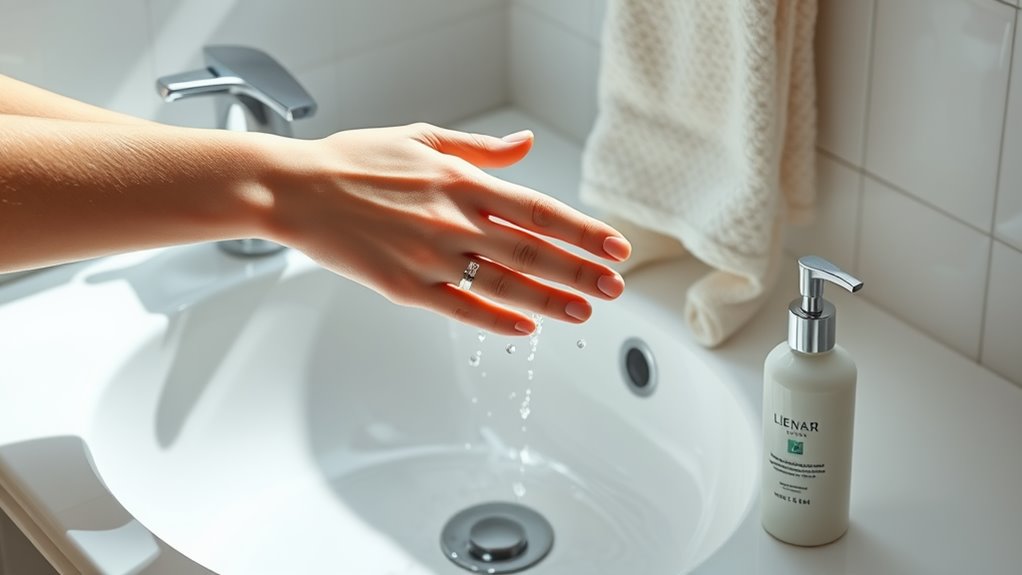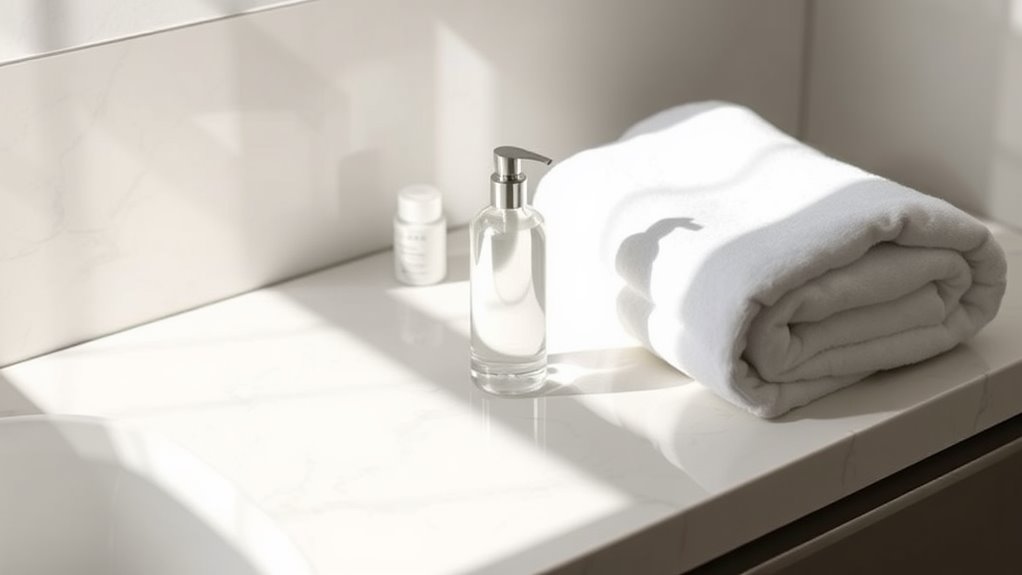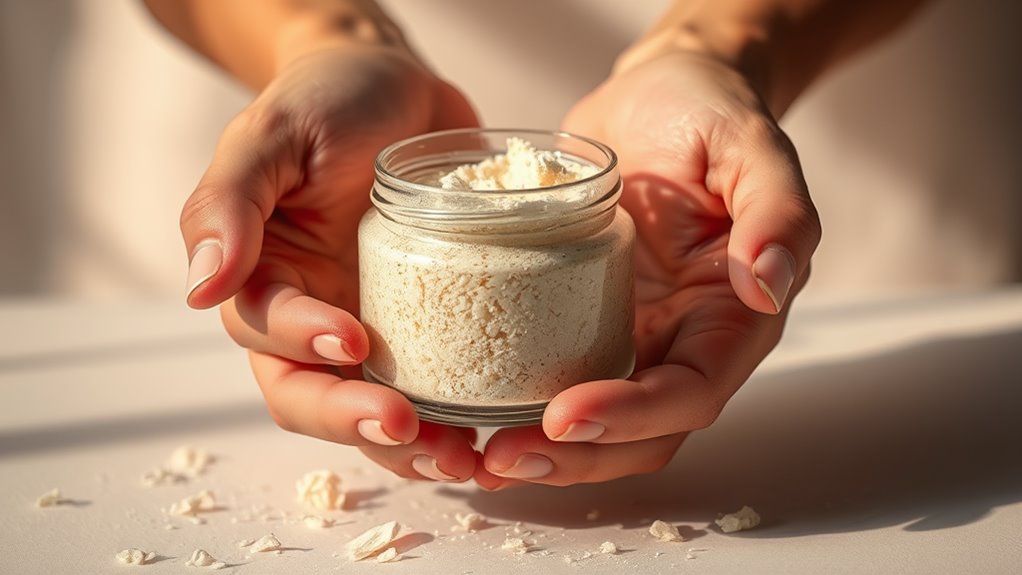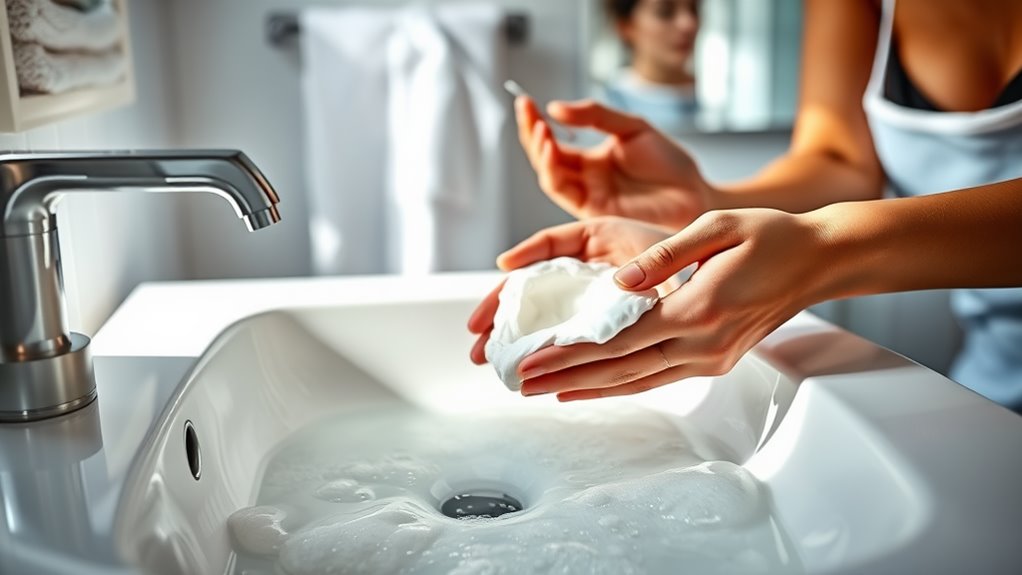Are You Washing Your Face the Wrong Way. Here’s What to Do Instead
You might be washing your face the wrong way, which can lead to skin issues. Start by understanding your skin type and using the right cleanser—gel for oily skin, cream for dry. Always wash your hands before cleansing and use warm water to prevent stripping moisture. Don’t forget the correct amount of product, and always rinse thoroughly. Lastly, choose soft towels and moisturize afterward to lock in hydration. For more tips on perfecting your routine, let’s explore further.
Key Takeaways
- Identify your skin type to choose the right cleanser that addresses your specific needs and concerns effectively.
- Always wash your hands thoroughly before cleansing your face to prevent transferring dirt and oils.
- Use lukewarm water for rinsing; avoid hot water to protect your skin barrier from damage and dryness.
- Pat your skin dry with a clean, soft towel instead of rubbing to reduce irritation and maintain skin integrity.
- Apply moisturizer on slightly damp skin post-cleansing to enhance hydration and lock in moisture.
Understanding Your Skin Type
Understanding your skin type is essential for effective skincare, as it helps you choose the right products and routines. Your skin can be categorized as normal, oily, dry, combination, or sensitive, each requiring tailored approaches.
For instance, if you have oily skin, opt for a gel-based cleanser that removes excess oil without stripping moisture. Conversely, if your skin is dry, a cream-based cleanser can help maintain hydration. Finding the Perfect Cleanser for your skin type ensures that you address your specific needs effectively.
Knowing your skin type not only enhances your face washing routine but also prevents adverse reactions from unsuitable products. Regular assessments of your skin’s condition can further refine your choices.
The Importance of Clean Hands
When it comes to washing your face, clean hands play a vital role in maintaining your skin’s health. Using dirty hands can transfer oils, dirt, and bacteria onto your face, leading to breakouts and irritation.
Studies show that hand hygiene significantly reduces the risk of skin infections. Before you cleanse your face, wash your hands thoroughly with soap and water for at least 20 seconds. This practice not only removes contaminants but also sets the stage for an effective skincare routine. Common face washing mistakes can often be traced back to neglecting this crucial step.
Remember, your hands touch multiple surfaces throughout the day, accumulating harmful bacteria. By ensuring your hands are clean, you’re taking an essential step toward achieving clearer, healthier skin.
Prioritizing hand hygiene can markedly enhance your overall skincare results.
Choosing the Right Cleanser
How do you know which cleanser is right for your skin type? First, identify your skin type: oily, dry, combination, or sensitive.
For oily skin, look for foaming or gel-based cleansers containing salicylic acid or tea tree oil to combat excess sebum.
If you have dry skin, opt for cream-based or oil cleansers with hydrating ingredients like glycerin or hyaluronic acid.
Combination skin benefits from a balanced cleanser that addresses both dry and oily areas.
For sensitive skin, choose fragrance-free and hypoallergenic options to minimize irritation.
Always check ingredient labels and consider patch testing a new product to ensure compatibility. A gentle cleanser is essential for avoiding harsh reactions on skin, which can lead to irritation and discomfort.
Understanding your skin’s needs is crucial for selecting a cleanser that promotes a healthy complexion.
The Temperature of Water Matters
While it might seem trivial, the temperature of the water you use when washing your face can significantly impact your skin’s health. Here’s how:
-
Warm Water: It effectively removes dirt and excess oil without stripping your skin’s natural moisture. Aim for lukewarm to avoid irritation.
-
Cold Water: This can help tighten pores and reduce redness, making it a good option for sensitive skin. It also refreshes and invigorates.
-
Hot Water: Avoid using hot water, as it can damage your skin barrier, leading to dryness and irritation. Additionally, using the right temperature for washing your face can enhance overall skin health by maintaining its natural balance.
The Correct Amount of Product to Use
Finding the right temperature for washing your face is just the start; the amount of product you use plays a significant role in your skincare routine. Using too little can leave your skin unclean, while too much may lead to irritation. Remember that using the right amount of product can help you avoid common daily face cleansing mistakes that could inadvertently harm your skin.
Here’s a quick reference guide to help you gauge the right amount of cleanser for different skin types:
| Skin Type | Recommended Amount |
|---|---|
| Oily | Pea-sized |
| Dry/Sensitive | Almond-sized |
| Normal/Combination | Nickel-sized |
Gentle Massaging Techniques
To achieve the best results from your cleansing routine, employing gentle massaging techniques is essential. This method not only enhances the effectiveness of your cleanser but also promotes circulation, leading to healthier skin.
Here are three techniques to incorporate:
-
Circular Motions: Use your fingertips to apply small, circular motions, starting from the center of your face and working outwards. This helps to lift impurities.
-
Upward Strokes: Always move your hands upward to counteract gravity. This technique helps firm and tone the skin.
-
Gentle Pressure: Apply light pressure without tugging or pulling. This reduces irritation and maintains skin’s integrity.
The Role of Timing in Cleansing
Understanding the importance of timing in your cleansing routine can significantly impact your skin’s health. Proper timing ensures that you’re effectively removing impurities while allowing beneficial ingredients to penetrate your skin. Here’s a quick reference to optimize your cleansing routine:
| Time of Day | Recommended Duration | Key Considerations |
|---|---|---|
| Morning | 30 seconds | Refresh and prep skin |
| Post-Workout | 1 minute | Remove sweat and grime |
| Evening | 1-2 minutes | Thoroughly cleanse pores |
| Weekly | 5-10 minutes | Use exfoliating products |
Rinsing Properly
Rinsing your face correctly is crucial for removing cleanser residues and impurities.
The temperature of the water you use and the duration of your rinsing process significantly impact your skin’s health and comfort.
Importance of Water Temperature
The temperature of the water you use while rinsing your face can significantly impact your skin’s health.
Using the right water temperature helps maintain your skin’s natural barrier and prevents irritation. Here’s what to consider:
-
Warm Water: It effectively opens pores, allowing for better cleansing of dirt and oil without stripping essential moisture.
-
Cool Water: This can help close pores after cleansing, sealing in hydration and promoting circulation for a refreshed appearance.
-
Avoid Hot Water: High temperatures can lead to dryness and irritation, exacerbating conditions like eczema or rosacea.
Duration of Rinsing Process
Spending at least 30 seconds rinsing your face can make a significant difference in your skincare routine. This duration allows you to effectively remove any lingering cleanser, oil, and impurities that could lead to breakouts or irritation.
Research indicates that rushing through the rinsing process can leave residues that may clog pores and disrupt your skin’s natural barrier.
To rinse properly, use lukewarm water and gently splash your face, ensuring all product is washed away. Pay special attention to areas like the jawline and hairline, where residue often accumulates.
The Impact of Towels on Skin
Choosing the right towel can significantly impact your skin health. The material and cleanliness of your towel play crucial roles in maintaining your skin’s integrity.
Here are three key considerations:
-
Material Matters: Opt for soft, absorbent materials like cotton or microfiber. These are gentler on your skin and help prevent irritation.
-
Hygiene is Essential: Regularly wash your towels to eliminate bacteria and dead skin cells. Using a dirty towel can lead to breakouts and infections.
-
Pat, Don’t Rub: When drying your face, gently pat your skin rather than rubbing it. This minimizes friction, reducing the risk of irritation and maintaining your skin barrier.
Incorporating these towel habits can enhance your skincare routine and promote healthier skin.
Moisturizing After Cleansing
After cleansing your face, applying a moisturizer is essential for maintaining skin hydration and overall health.
Moisturizers create a protective barrier, locking in moisture and preventing transepidermal water loss. This is particularly important after cleansing, as your skin may feel stripped of its natural oils.
Choose a product that suits your skin type—lightweight gels for oily skin, cream-based formulations for dry skin, and non-comedogenic options for sensitive skin.
Look for key ingredients like hyaluronic acid, glycerin, and ceramides, which help attract and retain moisture.
Apply your moisturizer while your skin is still slightly damp to maximize absorption.
Consistent use not only enhances your skin’s texture but also supports its natural barrier function, promoting a healthier appearance.
Establishing a Consistent Routine
Establishing a consistent skincare routine can significantly improve your skin’s health and appearance. A well-structured regimen helps maintain balance and addresses specific concerns. Here’s how to create one:
-
Choose Your Products Wisely: Select cleansers, toners, serums, and moisturizers based on your skin type and concerns. Look for evidence-based ingredients like hyaluronic acid and retinoids.
-
Set a Schedule: Stick to a morning and evening routine. Consistency is key in achieving long-term results.
-
Monitor Your Progress: Keep a skincare journal to track changes and product effectiveness. This helps you adjust your routine as needed.




